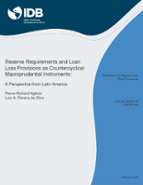Reserve Requirements and Loan Loss Provisions as Countercyclical Macroprudential Instruments: A Perspective from Latin America
Date
Feb 2016
This paper discusses, from an analytical and operational perspective, the use of reserve requirements and loan loss provisions as countercyclical macroprudential instruments. In recent years both of these instruments have been used extensively in Latin America and elsewhere in the world. The first part of the paper sets the stage with a discussion of the rationale, in the presence of financial frictions, for using macroprudential regulation to mitigate financial system procyclicality. The second part reviews the general arguments, as well as the recent empirical evidence for Latin America, associated with the use of reserve requirements and loan loss provisions. The third part provides a normative analysis of the ways through which countercyclical reserve requirements and cyclically adjusted (or, more commonly called, dynamic) provisioning rules should be formulated, independently and jointly, to address concerns arising from procyclicality and financial volatility. Optimal countercyclical rules are discussed from the perspective of how these rules can either minimize a composite measure of economic volatility (combining measures of both macroeconomic and financial volatility) or maximize social welfare. The last part brings together the lessons for policymakers that can be drawn from the analysis.



